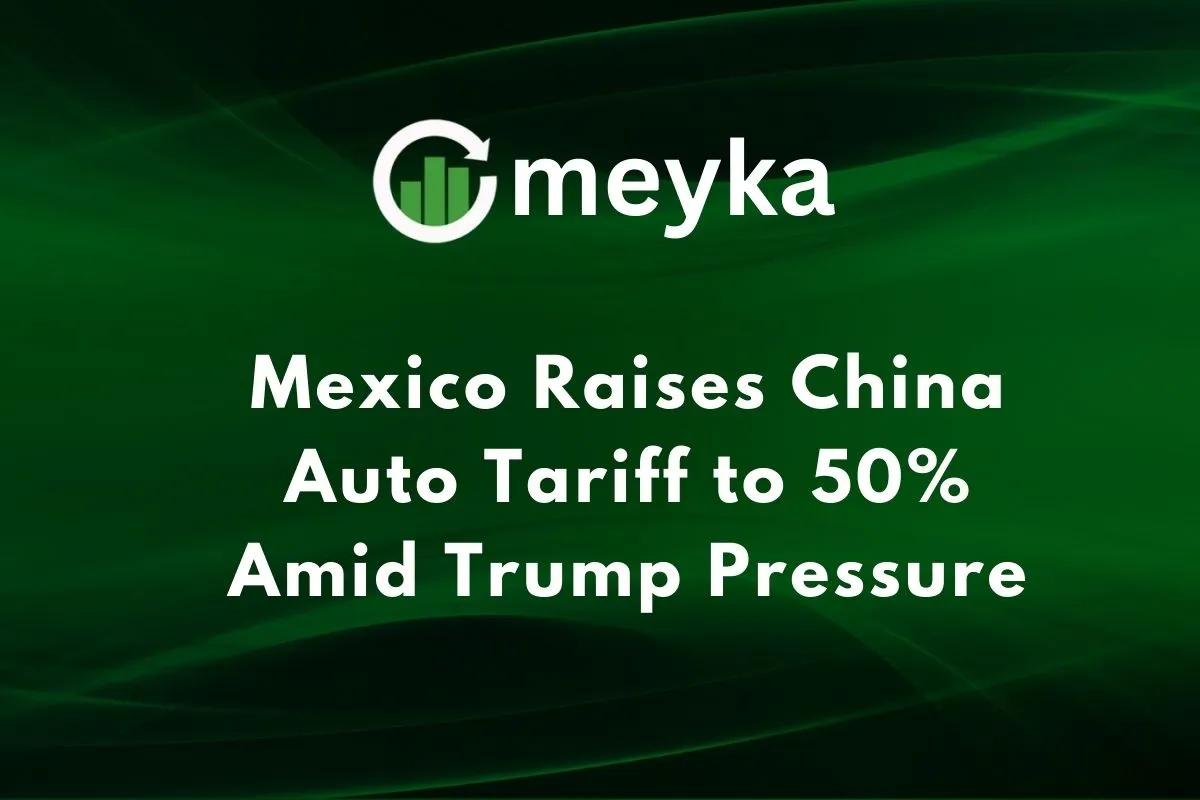Mexico Raises China Auto Tariff to 50% Amid Trump Pressure
Mexico has just moved to increase tariffs on cars imported from China and other Asian nations. The rate will go from around 20% to 50%. This decision is meant to protect local jobs, factories, and businesses that have been hurt by low-cost imports. We see this as part of a bigger shift in trade policy. Mexico is under pressure from the United States to curb Chinese economic influence.
Background: Mexico’s Role in Global Auto Trade
Mexico is a major player in the global car business. It makes millions of vehicles a year and exports many of them, especially to the U.S. The auto industry is a big share of Mexico’s manufacturing output.
Trade deals like USMCA (with U.S. and Canada) help determine how Mexico trades its cars and parts. These agreements give Mexico advantageous access into U.S. markets, but they also come with rules about where parts are made, etc. That means any change in tariffs or import rules can ripple through Mexico’s factories and workers.
Trump’s Pressure on Mexico
The U.S., under Donald Trump, has repeatedly pushed for countries in Latin America (including Mexico) to reduce trade dependence on China. The worry is that Chinese imports are undercutting local production and being used to access U.S. markets indirectly.
Mexico is responding, at least in part, to those U.S. trade and diplomatic pressures. By raising the China auto tariff, Mexico signals it’s aligning with U.S. concerns while trying to maintain its own economic sovereignty.
The Tariff Hike: What’s Changing?
- Rate change: Autos from China and some other Asian countries will face a 50% import duty. That’s up from about 20%.
- Scope: It applies to “light vehicles” and auto parts heavily. Mexico will also raise tariffs on many other goods from countries without free trade agreements.
- Legal limits: Mexico says this increase is the maximum allowed under World Trade Organization (WTO) rules.
- Duration / pending approval: Some parts of the plan still need congressional approval. The tariffs are tied to Mexico’s 2026 budget proposal.
China’s Rising Auto Exports
Over recent years, China has been exporting more cars abroad, including EVs and more affordable models. Low-cost manufacturing and economies of scale give Chinese automakers an edge in price.
In Mexico, Chinese cars have become more popular, partly because many consumers find them cheaper than other brands. Some of these imports have entered below what Mexico calls “reference prices,” meaning they are priced so low that they undercut the market.
Because Mexico is geographically close to the U.S., and because of trade flows, there’s concern that Chinese car exports to Mexico might serve as a backdoor route for cars or parts to reach U.S. markets with lower tariff exposure.
Economic and Trade Implications for Mexico
We expect both gains and risks from this tariff move.
Potential benefits:
- Protection for local automakers and parts makers. That helps save jobs and keep factories running.
- More government revenue from tariffs could help support Mexico’s national budget and industry funds.
Risks:
- Higher prices for consumers. Cars imported from China, and perhaps cars that use Chinese parts, are likely to cost more.
- Inflation pressure. As more goods have higher import duties, costs may rise across the supply chain.
- Investors may hesitate. Foreign firms that rely on imports or low-cost inputs could face higher costs. Some may delay investment until they see how strictly and how long the tariffs last.
U.S.-Mexico Relations and Strategic Positioning
This move helps Mexico show the U.S. that it is taking trade concerns seriously. The U.S. has been pressing Latin American countries to limit economic exposure to China. Mexico raising its China auto tariff fits that demand. Yet Mexico also wants to protect its own economic interests.
We from Mexico’s government are walking a fine line: satisfying U.S. pressure while keeping trade with China open enough for necessary parts, markets, and investment.
Also, timing matters: the USMCA trade agreement (with the U.S. and Canada) comes up for review. Showing willingness to act may help Mexico negotiate more from a position of strength.
Global Auto Industry Impact
This decision in Mexico is likely to ripple out.
- Other countries watching may adopt similar measures. Asia exporters such as China might face more barriers elsewhere.
- For automakers (Chinese and others), the cost of exporting to Latin America increases. They may shift strategy: build more locally, adjust pricing, or target different markets.
- EVs and new-energy vehicles could be less affected (if they are made partly locally), but affordability for consumers will matter.
Future Outlook
What might happen next?
- The tariff plan is expected to be approved by Mexico’s Congress, since the ruling party has a strong majority.
- If implemented fully, this may reduce Mexico’s trade deficit with China. Mexico already saw large deficits; the government sees tariffs as one tool to balance trade.
- But there may be indirect effects, like inflation or protests if car prices jump. Consumers may feel the impact.
- The policy may also affect Mexico’s relations with other Asian countries and could provoke diplomatic pushback.
10. Conclusion
Mexico’s decision to raise its China auto tariff to 50% is a bold move. We see it as a way to protect local industry. It’s also a response to trade pressure from the U.S. And it shows how global trade is shifting: countries are more willing to use tariffs to protect themselves.
While there are benefits, jobs saved, factories protected—the risks are real. Higher costs, inflation, and tension with partners. For now, we wait to see how Mexico balances all these forces.
This China Auto Tariff change will echo far beyond Mexico’s borders. It will test how well trade deals, politics, and economies can manage in a changing world.
FAQS:
Trump tariffs were meant to protect U.S. factories and workers. He believed foreign goods were too cheap. Tariffs raised import costs, encouraging people to buy more American-made products instead.
China exports cars and parts to Mexico at lower prices. From there, products can reach the U.S. with fewer trade barriers, helping bypass direct American tariffs.
Trump argued these countries traded unfairly with the U.S. He said they hurt American jobs. Tariffs on steel, aluminum, and autos were used to pressure for fairer trade deals.
Disclaimer:
This content is for informational purposes only and is not financial advice. Always conduct your research.






